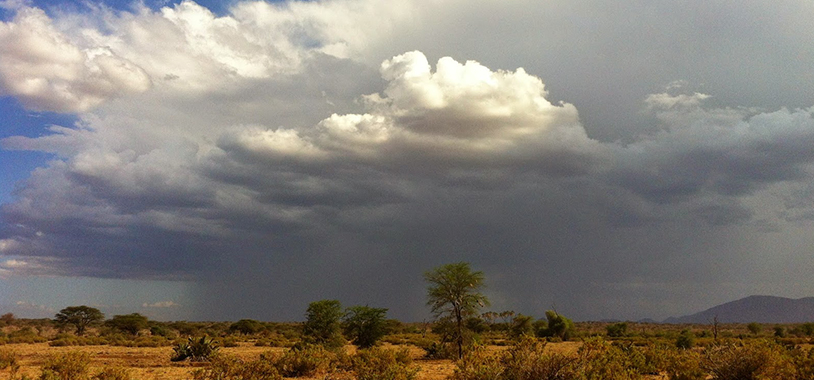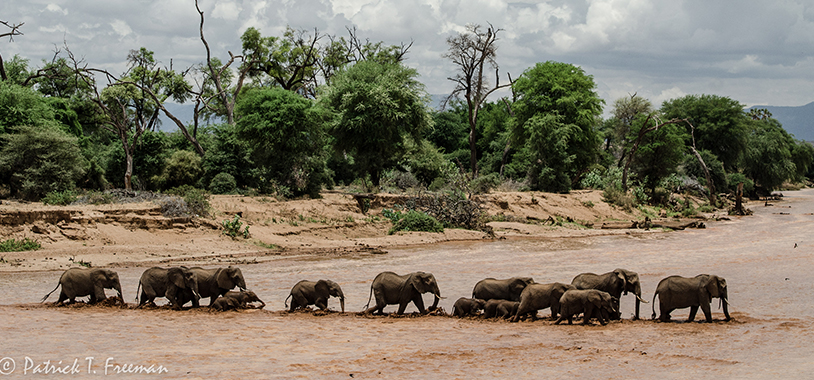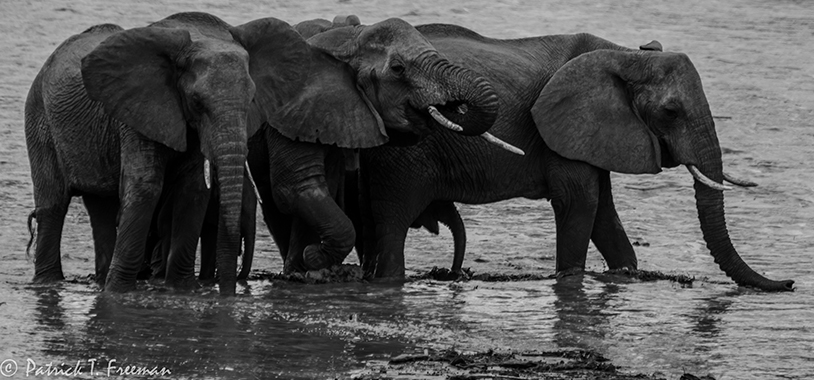For days clouds had collected – white puffs smattering the sky, some congregating around the peak of Mt. Kenya in the distance and piling high into thunderheads that might be delivering much-needed rains in far off territories. While the clouds provided some welcome relief from the sun – and made for some spectacular sunsets – rain remained only a weak promise.
About a week ago a thunderhead built up far in the distance and I watched it shift in color from puffy wool-white to a deep storm blue as the clouds stretched out from their atmospheric column. Curtains of purple began to stream from the clouds in the direction of Isiolo, many kilometers to our south and east. I held onto hope that it would stretch across the arid space between there and here but was disappointed when all we got were some dark, patchy clouds and a strong wind that whipped up Samburu sand in huge clouds of dust.
While out on our daily long-term monitoring drive last week we looked skyward as the clouds darkened yet again in their daily tease routine. I had stopped hoping too hard that it would rain, banking on the principle of the watched pot. But as we drove along the dirt roads, gusts of wind brought with them the earthy perfume of wet earth. Could it finally be happening? Samburu’s big skies make looking for rain a breeze as the clouds stretch out dramatically all around you – we saw the curtains far-off and crossed our fingers that they would envelope us. Our prayers were answered –if only briefly.
As we sat watching two young female elephants munch on some salt bushes, the wind picked up, heavy with the earthy perfume, and slowly, ever so slowly, the drops began to fall around us. The raindrops peppered the red dirt around our vehicle sending up little puffs of red. The elephants seemed to perk up ever so slightly as the temperature dropped and the rain slowly turned them from their dusty brown to a darker muddy color. I could do nothing but smile and stick my arms out the window to feel the coolness of the rain on my skin – relief.
But our shower was short-lived as the clouds broke up again as they drifted westward. The heat returned, now laden with moisture.
We drove back to our riverside route, hoping to collect more elephant observations on our back to camp, happy for the rain that we had but hoping desperately for more. As we approached a river outlook point where we had seen a herd digging wells for water earlier we nearly all fell out of our seats. Where there had been elephants only an hour ago there was now a rushing river of orangy-brown water. The first waters had arrived from the highlands.
All smiles, we continued along the river hoping to see happy elephants and other wildlife down by the water. We weren’t disappointed.
A conspicuous wonky splayed tusk, ripped ear, and a collar identified the matriarch of the family as Delaware, the leader of the Native Americans family. This large migrant family is known for ranging far and wide during the dry season rather than staying put in Samburu but we knew from Delaware’s collar data that she was in the area during the last week and had hoped to run across them on our LTM forays. Our reward for being patient was an incredibly iconic Ewaso river crossing with Delware at the helm, the other family members lined up behind her and pressed across, minding the strong current. The family has a large group of young calves that are all age-mates so the spectacle was enhanced by the excited splashing of rambunctious babies. The steel-blue tinged clouds piled high in the sky giving the whole scene the feeling of a painting. I’d hoped to see a river crossing during my time in Samburu and I’m so glad I was able to capture this beautiful behavior in real-time.
We left the Native Americans in peace and returned to camp to a few more sprinkles but little else. The following few days continued to promise rain but not deliver and the once rushing Ewaso emptied remarkably quickly much to my disappointment. Muddy remnants of moisture were all that remained, puddles and small trickles cutting their way through the silt and sand where they could.
But on the 25th, the skies grew very dark again and thunder began rolling through gray skies signifying more rain. A soft rain began to fall at around 3:00 p.m., dampening everything and creating the sweet smell of wet earth yet again. We soon got word from camps to our west that heavy rains in the mountains had produced enough water to jumpstart the Ewaso yet again. A wall of water was heading our way.
The camp gathered on the banks of the river, carved by the massive floods of 2010, with cups of tea waiting for the natural spectacle with excitement. Young children herded their herds of goats quickly across the muddy riverbed just as our ears picked up the low roar of water rushing towards us. We looked westward up the banks and there it was – a mass of the same muddy brown water roiling its way eastward.
Despite these attempts to jumpstart the rains, precipitation has been intermittent and rainclouds stubbornly drop rain all around us. The river has dried and filled twice following rainfall elsewhere, a continuous cycle of waiting. This natural process is fascinating – as old as time and a great teacher of patience and appreciation for the power that nature has to give and take away. I continue to hope that I can see some true torrential rainfall, the transformation of the Samburu landscape, and the return of large herds of elephants to this special place.




